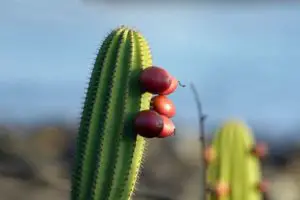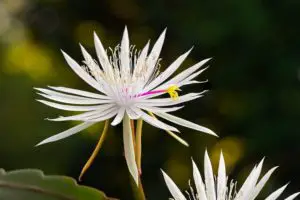Can A Cactus Survive A Freeze? (& Protection Tips)
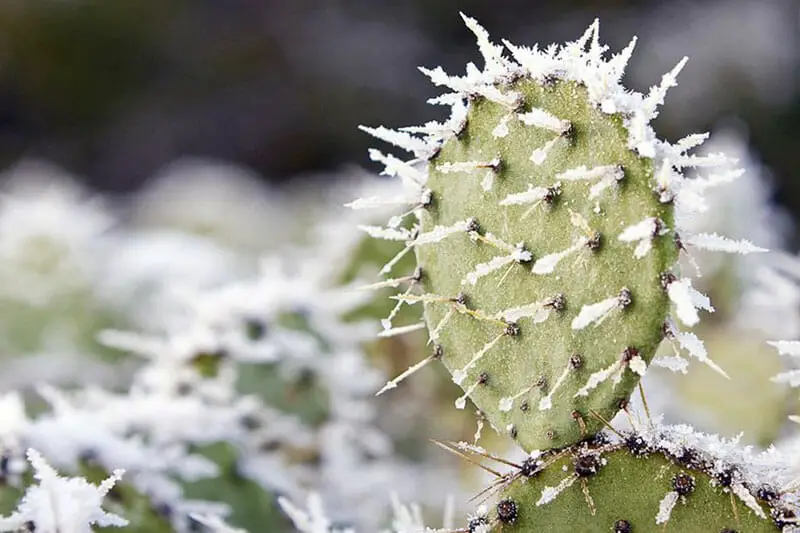
Cacti are known for their ability to survive the blazing hot, dry temperatures of desert environments, but what about cold temperatures?
Can a cactus survive a freeze?
Some adaptable cactus varieties can survive a freeze, because they have learned a few tricks that allow them to manage the cold as well as the heat.
Here’s how they do it.
The Big Freeze
In order to understand why cacti can survive a freeze, it’s helpful to first understand why cold can kill them in the first place.
There are two main reasons why cold damages plant tissues. The first has to do with the chemistry of plant biology.
Just like all organisms, there’s an optimal temperature for all the cellular processes that plants need to survive.
The colder they get, the more difficult it is for plants to continue these processes. This is the point at which most plants will enter a dormant phase, like deciduous trees in winter.
They aren’t able to grow or repair much damage in this state, though, so it can’t go on indefinitely.
And if temperatures dip toward 32 degrees Fahrenheit, there’s always the danger of freezing.
Freezing is the second danger of cold temperatures, and it’s the one that’s most deadly for plants.
When temperatures hit freezing, water begins to crystalize into ice, and, as anyone who’s ever forgotten a full water bottle in a freezer can attest, ice expands as it freezes.
The combination of sharp crystals and expansion causes plant cells to burst.
This is why plants that have frozen end up squishy and discolored—their internal structures have been turned to mush!
How Cacti Adapt To Freezing Temperatures
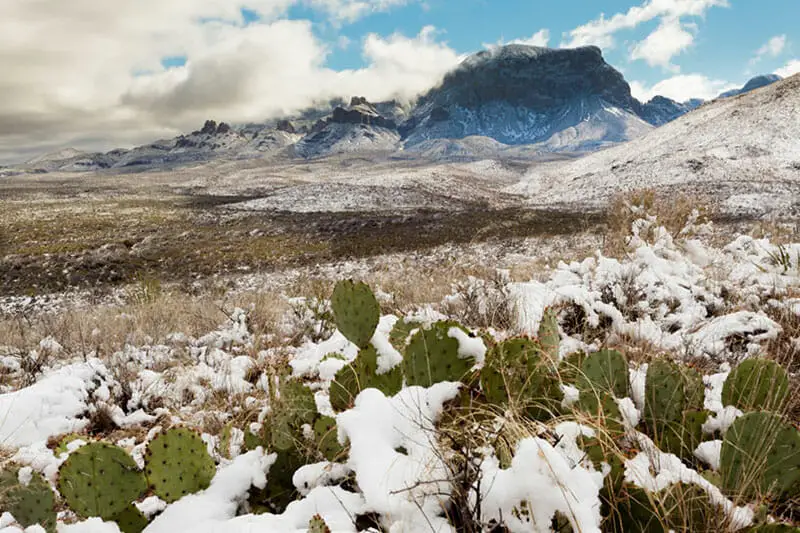
Not all plants are killed by cold, however.
There are several adaptations cacti use to survive when the temperatures drop, and they all have to do with managing water.
During the winter, when temperatures are likely to dip below freezing, cacti go dormant.
They stop growing and limit their cellular processes, which means they can live on less water.
Of course, this is one of the great adaptations for a desert-dwelling plant anyway, but it’s one that also keeps cacti from dying when the frost comes.
With less water inside the plant, there’s less risk of crystallization due to freezing.
The low water levels mean that the other compounds inside the plant’s cells are unusually concentrated.
This allows them to act like a natural antifreeze. It’s like trying to freeze sugar syrup rather than plain water, and offers the cactus quite a bit of protection.
If water levels aren’t low enough for this natural antifreeze to take effect, cacti may shift some of the water in their cells into the spaces in between cells—the interstitial space.
Here, larger crystals can form without destroying the plant’s cells, though freezing completely solid would still be a problem. Special proteins on the surface of cells help keep those larger crystals at bay.
Though these adaptations aren’t failsafes, they have an impressive effect.
Some types of cactus can survive temperatures as low as -30 degrees Fahrenheit!
Typically, they can’t survive long in such intense cold, but a night or two of bitter cold in midwinter won’t stop these hardy varieties from springing back to life when warm weather returns.
What Types of Cacti Can Freeze?
Despite their reputation for loving warm temperatures, there are lots of varieties of cactus that can be found growing wild in northern climates.
There are even types of cactus native to Canada!
Here are a few of those cold-hardy varieties.
- Prairie Hedgehog Cactus
Native to the American Rockies and Great Plains, these small mounded cacti are both hardy and pretty. They’ll put up with even harsh winter weather, though they do best when well-sheltered by mulch or snow during the coldest months. - Fishhook Barrel Cactus
This variety is unusual in that it is tolerant of both extreme heat and cold. It’s found in northern Mexico and the southern U.S, in desert areas where temperatures can swing widely from day to night. Water sparingly for optimal growth. - Texas Barrel Cactus
Covered in oversized spines, this cactus variety almost looks like a bird’s nest of thorns. It’s found primarily in the Chihuahuan Desert in northern Mexico and the American southwest, and is frost hardy down to five degrees Fahrenheit. - Santa Rita Prickly Pear
There are several varieties of cold-hardy prickly pear, and the Santa Rita is a favorite. When not actively growing, or when lightly stressed, the pads turn a beautiful rich purple that lend color to the garden year round. Though frost-hardy, this prickly pear can grow quite large—up to six fee tall!—so if unusually cold weather threatens, it can be tricky to protect. - Feather Cactus
Unique and unexpected, the feather cactus truly does resemble nothing so much as a ball of downy white feathers. It’s quite small, only a few inches across, and though it does well potted, it’s also surprisingly hardy for such a delicate-looking plant. - Eastern Prickly Pear
This is one of the more northern varieties of cactus native to the U.S, commonly found throughout eastern and central states. Like many prickly pear cacti, it’s frequently harvested for food— both the fruits and the pads are edible. As the weather grows drier and colder, the plant tends to shrivel and relax until it’s lying almost flat on the ground. It will perk right up come springtime! - Horse Crippler Cactus
So called because of its habit of hiding in low grass and its fierce spines, the horse crippler cactus is another native of the Chihuahuan Desert. Like most hardy cacti, it’s fairly small, growing in a low, hemispherical shape up to 12 inches in diameter. It’s bright pink blossoms make it a an excellent choice for growing potted or in gardens. - Cholla Cactus
There are many varieties of cholla (pronounced CHOY-ah) and though they differ widely in flower color, shape, size, and even stem color, they have a couple things in common: they can withstand cold weather and they’re very, very prickly! Novice cactus growers might want to steer clear, but die-hard cactus fans swear that once you learn to overlook the spines, the beautiful shapes and bright flowers will win you over.
Protecting Cacti From the Cold
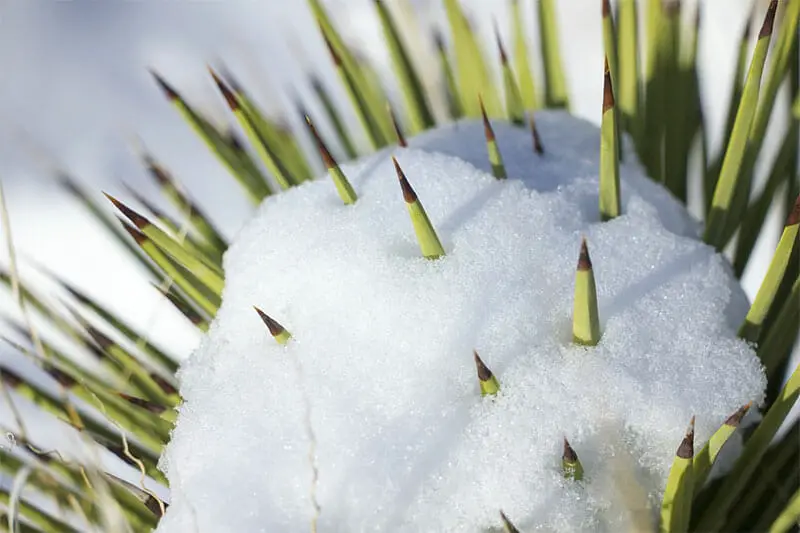
Getting ready for the cold season takes plants time, so they’re most vulnerable when temperatures fluctuate suddenly.
A cold snap can damage or kill even usually cold-hardy varieties. If you live somewhere that’s prone to unexpected freezes in the spring and fall, keep a close eye on the weather report and be ready to protect your cacti if temperatures take a sudden plunge.
The easiest way to protect your cacti is to move them to a warmer environment, so tucking small, potted cacti in the garage on frosty nights is a quick fix.
Larger cacti, or those that are part of the landscaping, will need a bit more help.
Water Your Cactus Less
As the weather begins to cool, water your cacti less and less, down to maybe only once every six weeks or so.
This will encourage them to enter their dormant phase and make it easier for them to survive cold snaps.
For low-growing plants, an extra layer of mulch will help them stay warm.
Don’t bury the plant completely, but build up a thicker layer than usual.
Using Much
Not only does mulch trap heat from the sun and hold onto it overnight, it also provides warmth as it begins to compost and break down.
Be very careful to use only lightweight mulch that doesn’t hold too much water, or your cacti will suffer root rot and die.
Straw can be a good option; avoid bark or wood shavings, which will be too dense and hold too much moisture.
How To Protect Taller Cacti
For taller cacti, plan to cover them on cold nights with frost cloth; in a pinch, the best protective solution is landscaping fabric (I recommend this affordable landscaping fabric available on Amazon), or shade cloth will do.
These materials will help trap a bubble of warm air around your plants and keep them from freezing.
Use stakes to support the cloth away from the plants; anywhere the fabric touches can drop as low as the surround air temperature, and you might end up with spots of frost damage.
You can also protect the tender growing tips of your cacti by covering them with Styrofoam cups.
Some frost cloth like this winterization blanket are designed to transmit light. This can be strung up to form tents or awnings and left in place all winter.
Any frost protection that doesn’t transmit light will need to be removed each morning.
Conclusion
Cacti may be desert-dwellers, but they’ve proven to be incredibly adaptable.
For some varieties, even a freeze can’t stop them.
Do you keep cold-hardy cacti? What tips do you have for keeping them growing strong even when the temperatures dip? Share in the comments!
